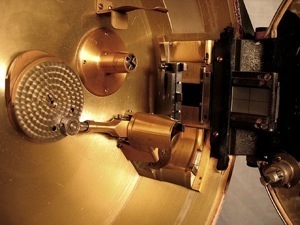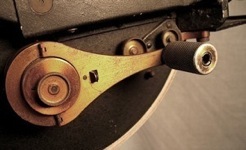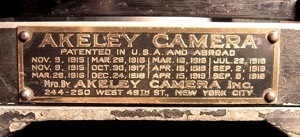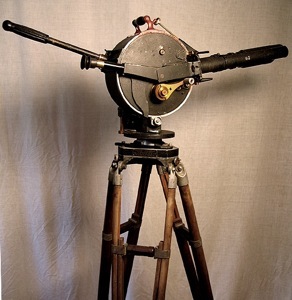
Akeley #265 Camera
Price upon request
Akeleys have a quick setup tripod. Most tripods made the operator set the tripod down and then take one of the legs and twist and turn it until the bubble was in the center of the level. Carl Akeley designed a ball leveling head. The operator just set the tripod down and then pulled a lever on the side of the head and used the ball mount between the head and tripod to get level and then he locked the ball in place. The tripod never had to be level, just the camera.
A shutter opening over 180 degrees was unheard of, as the mechanics of motion picture camera gears at the time wouldn’t allow for more than that. On all other movie cameras the shutter was a metal rotating disk between the lens and the film. On the Akeley camera the shutter is a curtain made from cloth and rotated all the way around the outside of the camera, thus the unusual and unique circular camera body. It allowed the Akeley camera to have a really large shutter angle of 230 degrees. Akeley cameras gave a cameraman the ability to shoot at lower light levels than other cameramen. They could shoot earlier in the morning and later in the evening. There is not now nor has there ever been a motion picture camera with a shutter opening of more than 205 degrees, other than an Akeley. By the way, the camera with a 205-degree shutter is new, right now and comes with a recommendation that it never be used, as there is some movement of the film before the shutter is completely closed.

This lens set gives a very dramatic look to the camera. I believe the lens is a Dallmeyer Dallon 17 inch F5.6 to F45 lens with a matching sidefinder. The patent number is 3096 dated 1914. They have no fungus and no lens separation and no chips or scratches. They will shoot today.
Video: Click the "Play" button to play video clip.
The camera is the smoothest and easiest cranking Akeley I have ever seen. The camera has been scratch tested and passed with flying colors.

The camera has the simplest of mechanics. It is designed to work easily and correctly every time. It will crank forwards and backwards with no changes of gears or belts. Double exposures were done simply by capping the lens and cranking backwards to where you wanted to start your double exposure. Seeing the care taken to put engine turning on the inside of the door it’s easy to tell the craftsmen that worked at the Akeley factory took pride in quality workmanship.


The movement is as simple as it can get. The finish on the inside of this camera is in incredible condition. It doesn’t get better than this.


There are two cranks on this Akeley. One is the main shooting crank and the other is a single frame crank. As with all hand-cranked cameras, the main crank is turned at two times a second. The single frame crank is for time-lapse. One turn of the crank is one frame.
This is an extremely rare camera. It would make an exceptional gift to someone in the film industry. It would be a matter of pride to bee seen in their office reception area or their home theater.
The following pictures are a tour around the camera. Enjoy!

Akeley cameras were first patented in 1915. World War II took the entire production of Akeleys during the war years. There are no records left from the Akeley factory so it is just a guess as to how many were made before 1919. The tripod with this camera has its last patent date as 1919 so my best guess is that this is an early 1920’s camera.



Akeley cameras are some of the rarest of all hand-cranked cameras. The highest serial number I have ever seen is 405. It is nearly the last camera Akeley made, if not the last. There were never 450 of these in existence.

I have been around antique hand cranked movie cameras for thirty plus years. I also worked as a cameraman in Hollywood for many years. I understand these cameras better than most people so I see them for more than their esthetic value. Yes, they have a look to them but for me they also have a feel to them. It is a user’s feel. Akeley #265 is a real working antique camera and will shoot film today.
Carl Akeley built a camera that was way ahead of its time. That statement sounds so trite and cliché but read along and I’ll explain why his cameras stand far out in front of their peers.
Akeleys had some features that were lost when sound came to the movie industry and weren’t revived until the 1950’s and even later. No camera today or in the past has a shutter angle larger than an Akeley camera did in 1915.
One other feature was the rotating eyepiece. The operator could look through the twin parallax lens and see what was actually going to be on the film. Both lenses were usually identical and had serial numbers that were right next to each other. The one the operator looked through usually didn’t have an iris so it always had the most light available to the ground glass. The Akeley viewer image was right side up and correct left to right. This was unheard of at the time. All motion picture cameramen were used to looking through a sidefinder whose image was upside down. Just like the large format billows cameras of the period they were used to working with.
The Akeley Gyro head was a leap in technology, not just an improvement. The operator could shift pan and tilt gears with the push of a button. The pan and tilt are gears spinning a gyro flywheel. These made incredibly smooth pans and tilts and were done by just putting pressure on the pan/tilt handle on the back of the camera. All other heads had cranks for the pan and tilt. In order to follow action a cameraman had to have three hands. One each to pan and tilt and crank the camera. Akeley cameras made a specialty class of cameramen possible. They were the action cameramen of their day. Akeley cameramen sold their ability to follow action by advertising to other Cinematographers in the American Cinematographer Magazines of the 1920’s. Akeley cameramen were very much like the SteadyCam operators of today. They got their work from the Directors of Photography rather than from the Director.